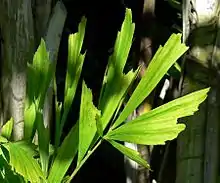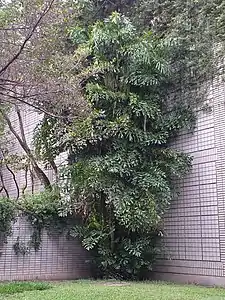Caryota mitis
Caryota mitis, known as the clustering fishtail palm or fishtail palm, is a species of palm native to Tropical Asia from India to Java to southern China, now sparingly naturalized in southern Florida and in parts of Africa and Latin America.[2][3][4][5][6] The species was originally described from Vietnam in 1790.[7] In Florida, it grows in hummocks and in disturbed wooded areas.[8]
| Caryota mitis | |
|---|---|
 | |
| Leaves of Caryota mitis | |
| Scientific classification | |
| Kingdom: | Plantae |
| Clade: | Tracheophytes |
| Clade: | Angiosperms |
| Clade: | Monocots |
| Clade: | Commelinids |
| Order: | Arecales |
| Family: | Arecaceae |
| Genus: | Caryota |
| Species: | C. mitis |
| Binomial name | |
| Caryota mitis Lour. | |
| Synonyms[1] | |
| |

Caryota mitis has clustered stems up to 10 m (33 feet) tall and 15 cm (6 inches) in diameter. Leaves can be up to 3 m (10 feet) long. Flowers are purple, and the fruits—harmful to humans—are dark purple or red.[7][9][10]
Uses
Cultivated mainly as an ornament plant in Cambodia, where it is named tunsaé töch, traditional healers burn the heaps of felted hairs from the leaves' axils to treat ill limbs of patients.[11]
Toxicity
The fruit of C. mitis is saturated with raphides, sharp, needle-shaped crystals of calcium oxalate. The raphides are strong irritants that cause damage and subsequent itching upon contact with skin, and if ingested, the mouth. This is a result of the physical structure of the raphides, and not any chemical reaction.[12]
Gallery
 Plant
Plant Characteristic of the grouping of trunks
Characteristic of the grouping of trunks Phyllotaxis
Phyllotaxis Phyllotaxis
Phyllotaxis Fruits
Fruits Fruits
Fruits Fruits
Fruits
| Wikimedia Commons has media related to Category:Caryota mitis. |
References
- The Plant List
- Berendsohn, W.G., A. K. Gruber & J. A. Monterrosa Salomón. 2012. Nova Silva Cuscatlanica. Árboles nativos e introducidos de El Salvador. Parte 2: Angiospermae – Familias M a P y Pteridophyta. Englera 29(2): 1–300.
- Idárraga-Piedrahita, A., R. D. C. Ortiz, R. Callejas Posada & M. Merello. (eds.) 2011. Flora de Antioquia: Catálogo de las Plantas Vasculares 2: 9–939. Universidad de Antioquia, Medellín.
- Linares, J. L. 2003 [2005]. Listado comentado de los árboles nativos y cultivados en la república de El Salvador. Ceiba 44(2): 105–268.
- Molina Rosito, A. 1975. Enumeración de las plantas de Honduras. Ceiba 19(1): 1–118.
- ORSTOM. 1988. List of Vascular Plants of Gabon with Synonymy, Herbier National du Gabon, Yaounde.
- Loureiro, João de. Flora Cochinchinensis 2: 569–570. 1790.
- Wunderlin, R. P. 1998. Guide to the Vascular Plants of Florida i–x, 1–806. University Press of Florida, Gainesville.
- Flora of North America v 22 p 115.
- Flora of China v 23 p 150.
- Dy Phon, Pauline (2000). Plants Utilised In Cambodia/Plants utilisees au Cambodge. Phnom Penh: Imprimerie Olympic. p. 136.
- Snyder, D S; Hatfield, G M; Lampe, K F (April 1979). "Examination of the itch response from the raphides of the fishtail palm Caryota mitis". Toxicology and Applied Pharmacology. 48 (2): 287–292. doi:10.1016/0041-008x(79)90035-8. hdl:2027.42/23600. PMID 473178.
